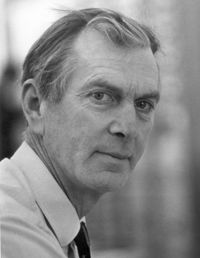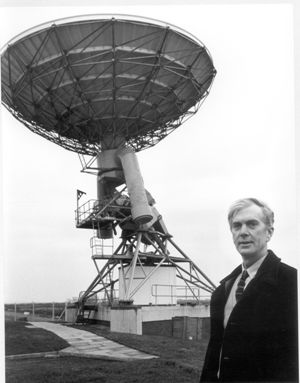Sir Martin Ryle, FRS
1918-84. Astronomer Royal. 
Martin Ryle read Physics at Oxford before working with the Telecommunications Research Establishment on the design of antennas for airborne radar equipment during World War II. After the war he received a fellowship at the Cavendish Laboratory.
The focus of his early work in Cambridge was on radio waves from the sun. His interest soon shifted to other areas, however, and to explore those he decided early on that the Cambridge group should develop new observing techniques. As a result, Ryle was the driving force in the creation and improvement of astronomical interferometry and aperture synthesis, which have contributed immensely to upgrading the quality of radio astronomical data. In 1946 he built the first multi-element astronomical radio interferometer. He was a Fellow of Trinity from 1949 until his death.
He guided the Cambridge radio astronomy group in the production of several important radio source catalogues. For example, the Third Cambridge Catalogue of Radio Sources (3C) 1959 helped lead to the discovery of the first quasi-stellar object (quasar).
While serving as university lecturer in physics at Cambridge from 1948 to 1959, Ryle became director of the Mullard Radio Astronomy Observatory 1957, and in 1959 became the first Professor of Radio Astronomy at Cambridge. He was elected a Fellow of the Royal Society in 1952, was knighted in 1966, and succeeded Sir Richard Woolley as Astronomer Royal (1972–82). Ryle and Antony Hewish shared the 1974 Nobel Prize for Physics, the first Nobel prize awarded in recognition of astronomical research. In 1968 he served as Professor of Astronomy at Gresham College, London.
| Memorial inscription | Translation |
|
MARTIN RYLE Eques Illustris. Astrologus Regius. Inter Cantabrigienses Professor. Huius Collegii Socius. Corona Nobeliana Honoratus. Stellarum naturam tam longe remotarum ut per lucis opem earum effigiem nemo excipere potuisset hic mentis oculis primus intuebatur dum patellas grandiores ordine serieque ita callide instruit ut undae brevissimae e caelo demissae effugere nequirent.
|
Sir Martin Ryle was Astronomer Royal, Professor at Cambridge, Fellow of the College, and a Nobel Laureate. He was the first to perceive with the mind’s eye the true nature of stars so far distant that their light is not strong enough to be seen; this he did by arranging large dishes in rows and lines so skilfully that the shortest wave sent from the sky could not escape. He died in 1984 at the age of sixty-six. |
Martin RyleBrass located on the north wall of the Ante-Chapel. |
Click on the thumbnail for a larger image. |
|
|
PREVIOUS BRASS |
|
NEXT BRASS Francis Henry Sandbach |
| Brasses A-B | Brasses C-G | Brasses H-K | Brasses L-P | Brasses R-S | Brasses T-W |

